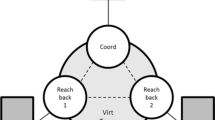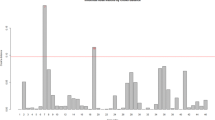Abstract
Team workload, which is usually described as an index of the ratio of available team resources to task demands, is believed to be critical for optimal human–computer integration. Although research conceptualizing team workload suggests that the measurement of team workload should consider workload unique to the team, the sum/min/max of members’ workload associated with taskwork referring to individual task performance is often used as an indicator of team workload. In order to better assess workload in team performance in which more than two individuals cooperate and conduct a task, it is also necessary to assess members’ workload associated with teamwork that refers to interpersonal interactions among individuals. The present study aims to develop a measure of workload associated with teamwork and discuss its contribution to operationalizing team workload. Results of team experiments indicate that the Teamwork Workload Scale is able to assess workload associated with teamwork and that it is necessary to assess both workload associated with taskwork and teamwork in order to better assess workload in team performance and operationalize team workload. In order to operationalize and measure team workload, it is necessary to investigate workload in team performance using quantitative data.



Similar content being viewed by others
Explore related subjects
Discover the latest articles, news and stories from top researchers in related subjects.References
Bedwell WL, Salas E, Funke GJ, Knott BA (2014) Team workload: a multilevel perspective. Organ Psychol Rev 4(2):99–123
Bonner MA, Wilson GF (2002) Heart rate measures of flight test and evaluation. Int J Aviat Psychol 12(1):63–77
Bowers CA, Jentsch F (2005) Team workload. In: Stanton N, Hedge A, Brookhuis K, Salas E, Hendrick H (eds) Handbook of human factors and ergonomic methods. CRC Press, Boca Raton, pp 57-1–57-3
Bowers C, Braun C, Morgan B (1997) Team workload: Its meaning and measurement. In: Brannick MT, Salas E, Prince C (eds) Team performance assessment and measurement: Theory, methods, and applications. Lawrence Erlbaum, Mahwah, pp 85–108
Byers JC, Bittner AC, Hill SG (1989) Traditional and raw task load index (TLX) correlations: are paired comparisons necessary? In: Mital A (ed) Advances in industrial ergonomics and safety, I. Taylor & Francis, London, pp 481–485
De Waard D, Lewis-Evans B (2014) Self-report scales alone cannot capture mental workload. Cogn Technol Work 16:303–305
De Winter JCF (2014) Controversy in human factors constructs and the explosive use of the NASA-TLX: a measurement perspective. Cogn Technol Work 16:289–297
De Winter JCF, Dodou D, Wieringa PA (2009) Exploratory factor analysis with small sample sizes. Multivar Behav Res 44(2):147–181
Funke GJ, Knott BA, Salas E, Pavlas D, Strang AJ (2012) Conceptualization and Measurement of Team Workload A Critical Need. Hum Factors J Hum Factors Ergon Soc 54(1):36–51
Hart SG (2006) NASA-task load index (NASA-TLX); 20 years later. In: Proceedings of the human factors and ergonomics society annual meeting, vol 50, no. 9. Sage Publications, Beverley Hills, pp 904–908
Hart SG, Staveland LE (1988) Development of NASA-TLX (Task Load Index): results of empirical and theoretical research. Adv Psychol 52:139–183
Henson RK, Roberts JK (2006) Use of exploratory factor analysis in published research common errors and some comment on improved practice. Educ Psychol Measur 66:393–416
Humphrey SE, Aime F (2014) Team microdynamics: toward an organizing approach to teamwork. Acad Manag Ann 8(1):443–503
Knott CC, Nelson WT, McCroskey MK, Miller BT (2008) Analysis of eye movements in change detection with teams using a simulated tactical situation display (Rep. No. AFRL-RH-WP-TR-20 09-0097, Air Force Research Laboratory). Defense Technical Information Center, Washington, DC
Kok A (1997) Event-related-potential (ERP) reflections of mental resources: a review and synthesis. Biol Psychol 45(1):19–56
Lean Y, Shan F (2012) Brief review on physiological and biochemical evaluations of human mental workload. Hum Factors Ergon Manuf Serv Ind 22(3):177–187
Lin CJ, Hsieh TL, Tsai PJ, Yang CW, Yenn TC (2011) Development of a team workload assessment technique for the main control room of advanced nuclear power plants. Hum Factors Ergon Manuf Serv Ind 21(4):397–411
Loft S, Sanderson P, Neal A, Mooij M (2007) Modeling and predicting mental workload in en route air traffic control: critical review and broader implications. Hum Factors J Hum Factors Ergon Soc 49(3):376–399
MacCallum RC, Widaman KF, Zhang S, Hong S (1999) Sample size in factor analysis. Psychol Methods 4(1):84–99
Martens M, Van Winsum W (2001) Effects of speech versus tactile driver support messages on driving behavior and workload. SAE technical papers, 06-0080
Morgan BB Jr, Salas E, Glickman AS (1993) An analysis of team evolution and maturation. J Gen Psychol 120(3):277–291
Morris R, MacNeela P, Scott A, Treacy P, Hyde A (2007) Reconsidering the conceptualization of nursing workload: literature review. J Adv Nurs 57(5):463–471
Pharmer J, Cropper K, McKneely J, Williams E (2004) Tactical Tomahawk weapon control system V6 land attack combat system prototype human-computer interface: test report for FY 03 fleet operability test (Tech. Rep. No. 3184). Naval Air Systems Command, Space and Naval Warfare Systems Center, San Diego, CA
Reid GB, Nygren TE (1988) The subjective workload assessment technique: a scaling procedure for measuring mental workload. Adv Psychol 52:185–218
Salas E, Sims DE, Burke CS (2005) Is there a “Big Five” in teamwork? Small Group Res 36(5):555–599
Salas E, Cooke NJ, Rosen MA (2008) On teams, teamwork, and team performance: discoveries and developments. Hum Factors J Hum Factors Ergon Soc 50(3):540–547
Tsang PS, Vidulich MA (2006) Mental workload and situation awareness. In: Salvendy (ed) Handbook of human factors and ergonomics, 3rd edn. Wiley, Hoboken, pp 243–268
Urban JM, Weaver JL, Bowers CA, Rhodenizer L (1996) Effects of workload and structure on team processes and performance: implications for complex team decision making. Hum Factors 38:300–310
Verwey WB (2000) On-line driver workload estimation. Effects of road situation and age on secondary task measures. Ergonomics 43(2):187–209
Young MS, Brookhuis KA, Wickens CD, Hancock PA (2015) State of science: mental workload in ergonomics. Ergonomics 58(1):1–17
Author information
Authors and Affiliations
Corresponding author
Rights and permissions
About this article
Cite this article
Nonose, K., Yoda, Y., Kanno, T. et al. An exploratory study: a measure of workload associated with teamwork. Cogn Tech Work 18, 351–360 (2016). https://doi.org/10.1007/s10111-015-0363-x
Received:
Accepted:
Published:
Issue Date:
DOI: https://doi.org/10.1007/s10111-015-0363-x




